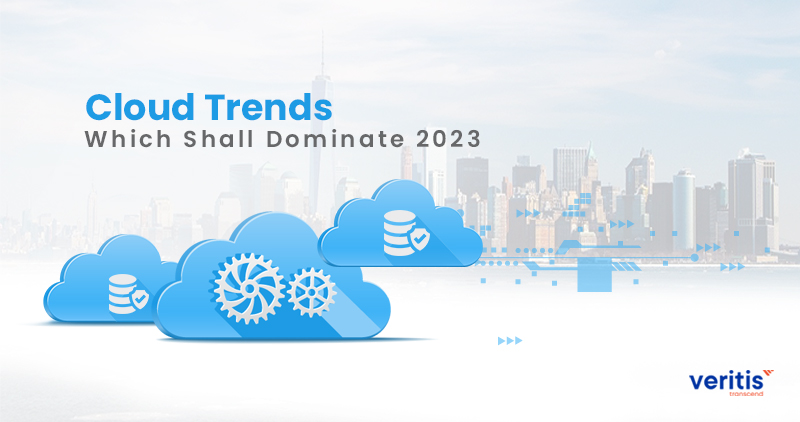
Cloud computing has reinvented plenty of things across the globe. From work culture to communications, cloud technology has propelled the world to new heights. After the unwelcome pandemic set in, many companies migrated to the cloud to deal with the production issues.
Cloud computing is one of the IT industry’s developing technologies that has grown most quickly. Although technology has been around for over a decade, its use has grown significantly in recent years. As a result, cloud computing will overtake all other technologies in 2023, given this growing tendency.
According to a survey by Accenture, switching to cloud computing can help businesses save up to 64% on energy costs and cut their carbon emissions by 64%! Moreover, it is anticipated that the cloud computing market size would exceed $1 trillion by 2028.
However, it is safe to say that cloud technology is evolving, and one should expect many more wonderful things to come along the way.
Let’s look at cloud computing, its functions, role, benefits, and what kinds of cloud computing trends we can anticipate in 2023.
Consult our Cloud Consulting Expert
What is Cloud Computing?
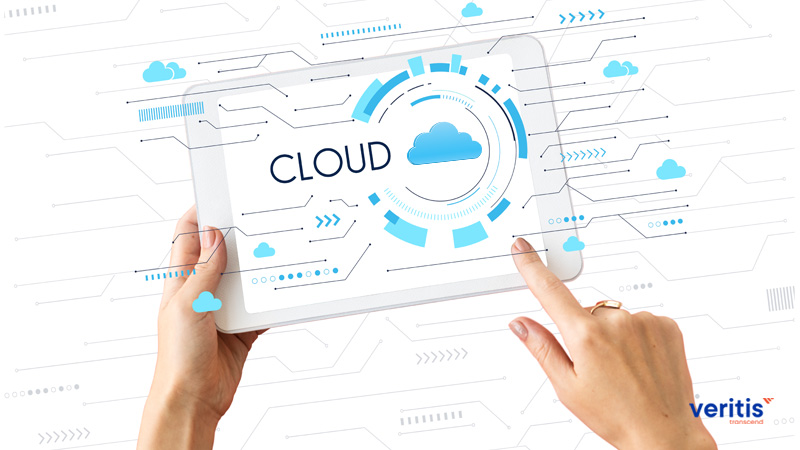
Cloud computing is the technique of providing on-demand IT services, such as storage, servers, networking, analytics, and databases, through the internet. These virtual services offer quicker innovation, simple scaling, and better resource flexibility.
Cloud computing is a cost-effective way to integrate IT into your company without investing in an internal data center because most cloud models only charge you for the services you use. Virtual services such as Platforms as a Service (PaaS), Infrastructure as a Service (IaaS), and Software as a service (SaaS), to mention a few, are included in cloud technologies.
To assist in constructing hybrid IT solutions, we can envision the future of cloud computing as a blend of cloud-based software products and on-premises computing. The future of cloud computing makes the IT industry’s future more promising.
The early 1960s marked the beginning of the history of cloud computing. The use of remote job entry during this time gave rise to time-sharing notions. This lingo was used by IBM and DEC (Digital Equipment Corporation). By the beginning of the 1970s, full-time-sharing systems were accessible because of this increase. However, few telecommunications behemoths began providing VPN (virtual private network) services in the 1990s at competitive prices. It allowed them to use the network more efficiently because they could swap traffic with correct server utilization. The cloud concept for virtualized services first appeared around 1994.
Useful link: Multi-cloud, the Future of Enterprise Cloud Computing
How Does Cloud Computing Work?
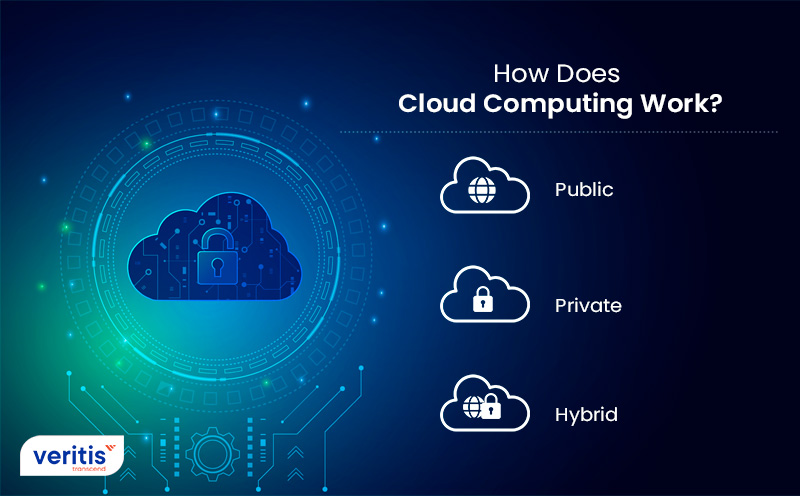
The three cloud technology deployment strategies must examine if we are to have a better understanding of how cloud technologies operate.
1) Public
The most prevalent and well-liked kinds of clouds are public ones. Cloud migration strategy services make this product available to clients, and resources are reachable over the open internet. The providers handle everything relating to infrastructure. Amazon Web Services (AWS), Google Cloud Platform, and Microsoft Azure are just a few examples of providers.
2) Private
An internal data center is comparable to a private cloud. However, virtualization allows the business to utilize common cloud computing advantages like scalability and resource sharing while paying for, managing, and using the infrastructure and personnel.
3) Hybrid
The hybrid cloud incorporates both types of clouds by connecting the public and private cloud models with the internet and virtual private networks. The hybrid approach is perfect for companies that wish to have an offsite virtual backup for disaster mitigation or need more computing capacity since they have used up all their internal resources. In addition, hybrid works incredibly effectively if a company has data stored on public cloud adoption, freeing up storage capacity in the private cloud for private and secret data.
Regardless of the model they select, clients look around for the best cloud provider and select the services they wish to employ (SaaS, IaaS, PaaS). You can perhaps already be utilizing a SaaS without being aware of it! You use SaaS if you use programs such as Microsoft Office 365, Slack, Dropbox, or DocuSign.
Since cloud service providers sell subscriptions, customers choose their usage level (many offer escalating user tiers) and pay a monthly or yearly charge to access the relevant resources.
Useful link: Hybrid Cloud Vs Multi Cloud: What’s the Difference!
What Role Does the Cloud Play?
The cloud has revolutionized the IT industry, and its impact is only growing. The importance of the cloud can be attributed to various factors. First off, it’s efficient. You can use any computer or mobile device with an internet connection to view your data and applications. Second, it works well. A lot of data may be stored on cloud migration services, and you can quickly scale it up or down as your needs change.
Thirdly, it is adaptable. Cloud adoption can be used for many things, including storage, processing power, and software-as-a-service (SaaS) applications. The fourth—and possibly most significant—fact is that the cloud is safe. Your data is backed up in many places and kept in safe data centers. As a result, your data will be considerably less likely to be lost or compromised.
Benefits of Cloud Computing
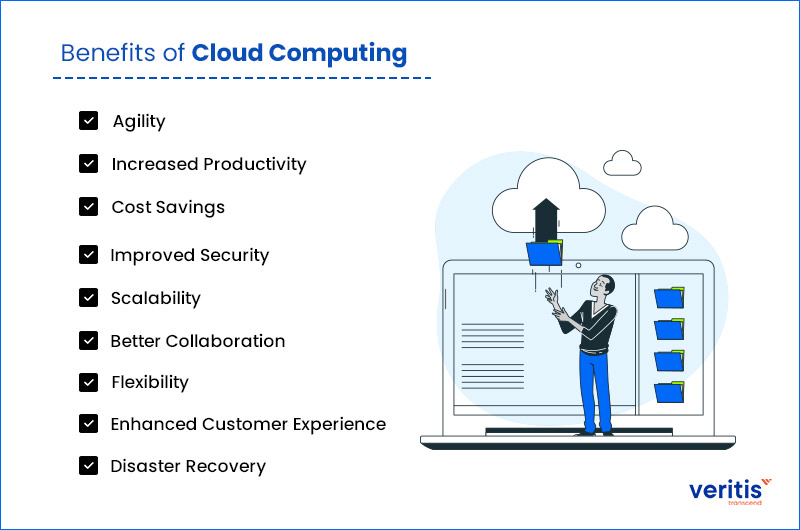
1) Agility
Cloud computing can aid companies in being more agile. This implies that businesses can swiftly roll out new apps and services and thus be more sensitive to changes in the market environment.
2) Increased Productivity
Employee productivity can increase with the use of cloud computing. For instance, they can utilize any device and access cloud-based applications and services anywhere.
3) Cost Savings
Cost savings are one of the critical advantages of cloud computing. For instance, companies no longer need to make costly on-premises hardware and software investments. Instead, customers can use pay-as-you-go to access cloud-based programs and services.
4) Improved Security
Cloud computing can provide better cloud security systems than conventional on-premises IT infrastructure. This is because cloud service providers are security experts and can provide a range of security measures, including data encryption and intrusion detection.
5) Scalability
The scalability of cloud computing is very high. This implies that when their needs change, firms may quickly scale up or reduce their consumption of cloud-based resources.
6) Better Collaboration
Employee cooperation can enhance with the use of cloud computing. For instance, they can access programs and services anywhere and share files and documents more readily.
7) Flexibility
A further advantage of cloud computing is its increased flexibility over conventional on-premises IT architecture. Businesses, for instance, can readily release resources when they are no longer needed and provide new ones rapidly as needed.
8) Enhanced Customer Experience
Businesses may enhance their customers’ experiences through cloud computing. This is so that companies can give clients a better experience by using cloud-based applications and services.
9) Disaster Recovery
Businesses may recover from calamities more quickly with the use of cloud computing. They can do so because they have access to cloud-based backup and recovery services.
10) Environmental Benefits
Businesses can lower their carbon footprint with the use of cloud computing. This is because cloud service providers run their businesses using renewable energy and energy-efficient data facilities.
Useful link: 5 Cloud Computing Benefits to Automotive Industry
Cloud Computing Trends
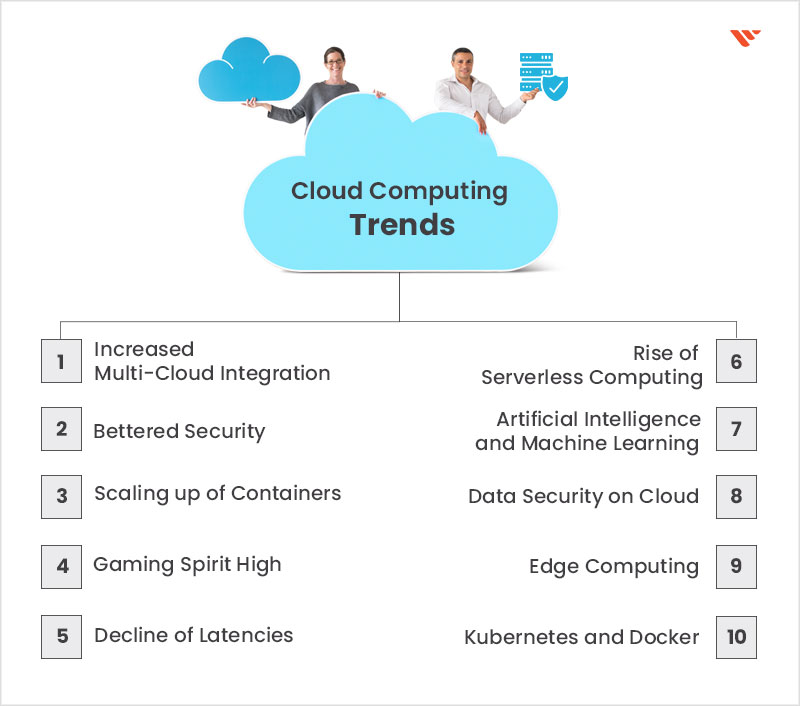
1) Increased Multi-Cloud Integration
Companies and cloud providers have realized that one cloud technology is not enough for organizational needs. Be it Azure or Google Anthos, cloud solutions providers have taken cognizance of the demand for multi-cloud compatibility. This is primarily because organizations no longer want to restrict themselves to one single cloud as they want to enjoy the best from multiple worlds or, in this case: clouds.
These cloud computing trends, which are in their nascent stage now, will pick up the pace, as surmised by a report of Flexera.
As per that document, 93% of the surveyed companies have multi-cloud designs, and 87% have hybrid cloud strategies. These percentiles will only go up over time as global demand is scaling up.
2) Bettered Security
Post-pandemic, companies across the world are facing cyberattacks from various routes. From the colossal SolarWinds to the shocking Volvo hack, many notorious cyber incidents left the world unpleasantly spellbound. This has increased focus on cloud security systems, and the approach that you alone will protect your company will be risky.
With multiple breaches being witnessed, it is no surprise that organizations of all scales will focus on robust security solutions which third-party companies would tender. In the meantime, companies that cannot afford third-party cloud security systems can educate their personnel about the potential security risks and empower them by training them. Lastly, stringent rules and policies should be enforced to avoid snafus of any sort.
3) Scaling up of Containers
Containers are utilized substantially as they are easy to develop and deploy. This advantage is swift and better as collaboration and modernization are much more coordinated. Gartner estimates that 75% of world organizations will employ containers in current market. Currently, containers are used less than 30%. This containerization boost paves for many constructive possibilities.
4) Gaming Spirit High
Thanks to the pandemic, online gaming was boosted as many were forced to be home. This trend has subjected game creators to look at the cloud migration services to meet the demand. The cloud cost management strategies industry has also noted this demand and provides gaming-as-a-service to cloud adoption users. From Azure to Google Cloud, every primary cloud provider has developed great features that acknowledge the rise of gaming services.
With COVID-19 taking its sweet time to fade, one can only expect this demand to grow. There is no doubt about cloud tech as the significant cloud market players are pulling out all the stops to support this exponential gaming growth.
5) Decline of Latencies
Cloud giants are working on stunting latency and outages of any sort. For instance, Microsoft has already begun testing underwater server tubes to establish robust connectivity. Similarly, Google has also doled out Google Cloud products, making latency a tale of the yore. This is due to how increasingly reliant the world has become on cyber solutions. The reliance will only increase, which is motivation enough for cloud providers to decrease latencies.
Useful link: Cloud Monitoring: Global Market Trends and Forecast!
6) Rise of Serverless Computing
In-house server infrastructure has many challenges, including exceptionally high CAPEX and OPEX. This enticed businesses to go serverless, a powerful new way to address server snafus. Serverless computing enables organizations to reduce IT operational costs, auto-scale demand, and deploy services faster.
Moreover, it offloads all server infrastructure tasks, like provisioning, scheduling, scaling, patching, and more, to the cloud provider. This facilitates developers with more time to focus on their core development tasks. And with serverless, businesses never pay for over-provisioning. Instead, they pay only for the infrastructure support they need. Given the enticing benefits of going serverless, these cloud migration strategy trends will only go up over time.
7) Artificial Intelligence and Machine Learning
Cloud computing is strongly related to artificial intelligence (AI) technologies and machine learning (ML). Automation, increased efficiency, and wiser decision-making are all possible with AI and ML.
We may anticipate an increase in the integration of AI and ML into cloud technologies as cloud computing trends continue to develop and grow. Greater automation and self-learning capabilities, improved data protection and privacy, and more individualized cloud experiences are some of the major themes that are likely to emerge in this field.
8) Data Security on Cloud
Data security on the cloud protects cloud-stored data against unauthorized access or erasure. It frequently consists of protections such as activity tracking, access restriction, and encryption.
Although cloud computing offers many advantages, like improved productivity and scalability, data security is still a top issue for many organizations. This is because cloud application migration services may be vulnerable to security breaches brought on by hackers or hostile insiders, data leaks brought on by software defects or a human mistake, compliance concerns brought on by data kept on remote servers under the control of the organization, and other issues. Companies are utilizing open-source technology and cloud platforms to optimize their cloud spending, and data storage on the cloud is also expanding.
Organizations are adopting several steps to protect sensitive data in the cloud application migration to solve these issues. These include using cutting-edge encryption methods like zero-knowledge cloud storage; strict access controls and multi-factor authentication systems to prevent unauthorized access; and continuous monitoring tools like cloud security information and event management (CSIEM) systems to detect and react to suspicious activity.
Organizations must be alert and actively participate in securing their cloud environments to help reduce the risks associated with data storage in the cloud migration strategy, even while cloud providers are also working to enhance data security.
9) Edge Computing
Edge computing is one of the most significant cloud computing trends going forward. Edge computing is a distributed computing approach in which data processing occurs at the network’s edge near the data source. This decreases latency and enables faster processing.
Due to its many advantages, such as faster data transmission and better efficiency, edge computing has become a significant trend in cloud cost management strategies. By processing data at the network’s edge, cloud transformation providers can reduce bandwidth costs, reduce latency, and provide excellent reliability for critical applications.
Additionally, edge computing is the perfect option for financial services, healthcare, and retail sectors that need low-latency data processing.
10) Kubernetes and Docker
Increased use of container orchestration tools like Kubernetes and Docker is one significant trend we can anticipate. These technologies will be an essential part of cloud transformation architecture, allowing for massive deployments that are incredibly scalable and effective.
Over the coming years, these two quickly developing technologies will continue to be critical participants in cloud application migration developments. Many businesses are turning to Kubernetes and Docker as practical solutions for managing their cloud installations as cloud computing becomes increasingly popular.
Capping it off
Change is inevitable, and the swiftness of the world is encouraging innovation. As the needs of the world change, entrepreneurs across the planet are reinventing their technologies to suit the requirements. However, future-proofing your enterprise is a pertinent aspect as perpetual changes in work culture dynamics are not something that the employees will always welcome.
Taking this into account, most of the companies have outsourced their work to Veritis, the Stevie Award winner. Our in-house experts create custom solutions that are efficient and cost-effective. Collaborate with us and walk away with a solution that stands the test of time.
Explore Cloud Services Got Questions? Schedule A Call
More Articles:
- 5 Considerations for Drafting a Multi Cloud Strategy
- Cloud Migration and IT Infra Support to Multimedia Industry
- Multi-Cloud Environments Alter Firms’ Cloud Strategies
- Cloud: The Technology Reinventing the Global Work Culture
- Cloud Adoption Strategy: Which Approach Would be Most Effective for Your Company?
- What is Cloud Migration? Strategy, Process, and Tools
- All You Need to Know About Top 10 Security Issues in Cloud Computing